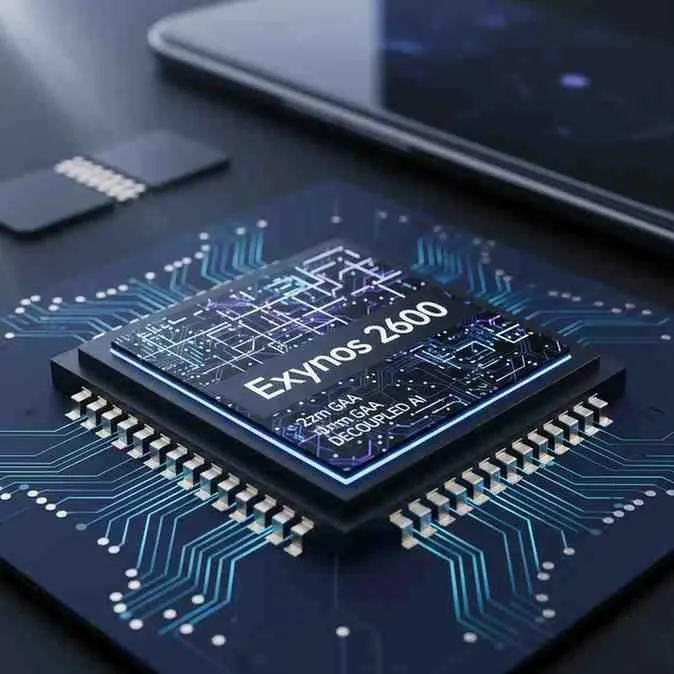For years, the mere mention of an Exynos chip powering a flagship Galaxy model has been met with dread. The S22 series’ thermal issues cast a long shadow, forcing Samsung to rely on a Snapdragon-only strategy for the S23 and S25 Ultras. It was an admission of defeat for Samsung’s in-house silicon, and consumers largely rejoiced at the consistency a unified chip strategy brought.
This is why the latest internal testing reports, leaked from Korean media, are so shocking: they suggest the Exynos 2600 isn’t just catching up to the competition-it’s poised to outperform it. Rumors indicate the Galaxy S26 series, possibly including some Ultra variants, will feature this new Exynos chip, with internal benchmarks suggesting it is remarkably faster than the latest Snapdragon 8 Elite Gen 5 in key areas.
This article will pull back the curtain on these incredible performance claims, detail the groundbreaking technical reasons behind this potential jump, and discuss the huge risks and rewards of this audacious strategy shift for both Samsung and us, the consumers.
Table of Contents

The Performance Claims: A Technical Breakdown
If you’re a longtime Galaxy fan, you’ve likely experienced the “Exynos lottery” – the frustrating realization that your region’s phone performed worse than others. This past disappointment makes the current leaks about the Exynos 2600 all the more difficult to believe, yet also incredibly exciting.
The Reported Gains: Exynos 2600 vs. Snapdragon 8 Elite Gen 5
According to Samsung’s internal test results, the Exynos 2600 is not only competitive but, in specific benchmarks, appears to beat both the Apple A19 Pro and the unreleased Snapdragon 8 Elite Gen 5.
| Performance Area | Exynos 2600 Advantage (Reported) | Significance |
| NPU (AI) | Up to 30% faster than Snapdragon 8 Elite Gen 5 | This is the crucial battleground for the future of mobile intelligence. A superior NPU means faster on-device AI features like instant language translation, advanced photo editing, and more intuitive user interfaces for Galaxy AI. |
| GPU (Graphics) | Up to 29% stronger than Adreno 850 (Snapdragon) | A massive generational leap that could finally put Exynos back in the game for serious mobile gaming performance, offering smoother frame rates and more detailed graphics, rivaling or even surpassing Apple’s latest. |
| CPU (Multi-Core) | Up to 14% higher than Apple’s A19 Pro | While direct comparisons to Snapdragon vary, a consistent lead over Apple’s chip in multi-core tasks suggests significant improvements in raw processing power for heavy multitasking and demanding applications. |
If these numbers accurately translate to the final product, the Exynos 2600 would not only be a top contender but potentially the most powerful SoC in the Android market. This level of confidence is what has reportedly convinced Samsung to go “all-in” on their own silicon for a significant portion of the S26 series, including, controversially, some Ultra models.
Why the Vexlimo Caution is Necessary
Now, here is the essential Vexlimo reality check. As an informed buyer, you must take these early, leaked results with a heavy grain of salt.
Samsung’s internal testing environment is not the real world. Every past Exynos failure wasn’t due to poor burst performance (the chip running for a few seconds under ideal conditions); it was primarily due to poor sustained performance and inadequate thermal management under continuous load.
- The Thermal Throttling Trap: A chip can achieve staggering scores in a cold, controlled lab environment. The true test for the Exynos 2600 is what happens after 20 minutes of 4K video recording or a 30-minute high-end gaming session. If the phone runs too hot, the performance will inevitably throttle (cut back power) dramatically to save the battery and internal components, leading to a frustrating user experience.
- The Buyer’s Focus: Don’t obsess over the 29% GPU lead. Instead, when early reviews for the S26 series emerge in early 2026, look for insights that address the three key variables that actually impact your daily use:
- Sustained performance consistency under load.
- Battery efficiency across various tasks, especially on 5G networks.
- Modem stability and reliability (a crucial and historically weak point for Exynos).
The performance on paper is a miracle. The performance in your hand is all that matters.
The Technical Leap: Samsung’s Game-Changing Technology
So, what exactly has Samsung done differently to potentially turn the tide? The answer lies in fundamental changes to both chip manufacturing and design, aiming to directly address the thermal and efficiency issues of the past.

The 2nm Gate-All-Around (GAA) Process: A Foundry Breakthrough
The Exynos 2600 is rumored to be the first major mobile SoC to be manufactured using Samsung’s cutting-edge 2nm Gate-All-Around (GAA) process. This isn’t just a slight improvement over older techniques; it’s a paradigm shift in how transistors are built.
Traditionally, chips used FinFET technology, where the transistor gate wraps around three sides of the fin-shaped channel. GAA, on the other hand, allows the gate to completely surround the channel, creating a more efficient and powerful transistor.
- GAA Advantage: This architectural change offers better control over current leakage, significantly reduces power consumption, and allows for higher transistor density. In simple terms, it means more power in a smaller, more efficient package, directly translating to lower heat generation and improved battery life. This is the foundational technology that could finally put Exynos on par with-or ahead of-Qualcomm and Apple.
Solving the Thermal Crisis: Decoupled Design and Heat Pass Blocks
Beyond the manufacturing process, Samsung has reportedly implemented smart architectural changes to tackle the thermal demons that plagued previous Exynos chips.
- Decoupled Modem: One of the most significant rumored design changes is the separation of the 5G modem from the main Application Processor (AP). In many integrated designs, the modem generates considerable heat, which then impacts the performance of the CPU and GPU. By decoupling it, Samsung can reduce the overall thermal load on the main compute cluster, allowing it to run at higher speeds for longer without throttling.
- Integrated Heat Pass Block (HPB): Alongside the decoupled modem, leaks suggest the Exynos 2600 integrates a new “Heat Pass Block” (HPB). While specifics are scarce, this is essentially a more efficient on-die thermal management element designed to actively pull heat away from the critical silicon components, channeling it towards the phone’s larger cooling system. This is a targeted approach to managing heat at its source, a crucial step for sustained high performance.
These technical advancements, if true, represent a concerted effort by Samsung to not just increase raw power but to fundamentally redesign their chip architecture to achieve a balanced, high-performing, and thermally efficient SoC.
The Strategic Shift: Why Samsung is Making This Gamble
Beyond the technical prowess, Samsung’s decision to bring Exynos back to the forefront of its flagship line is a strategic move with significant financial and market implications. This isn’t just about a faster chip; it’s about control, cost, and market dominance.
- Cost Cutting and Profit Margins: Forcing Qualcomm into a sole-provider position for its flagship chips cost Samsung an astronomical sum – reportedly trillions of Korean won annually. By splitting the S26 series (and potentially future flagships) with its own Exynos chips, Samsung could halve its annual AP purchasing costs. This directly translates to healthier profit margins for their mobile division.
- Foundry Confidence and External Clients: The Exynos 2600 serves as a critical “litmus test” for Samsung’s advanced 2nm manufacturing process. If the chip performs as rumored, it will be a massive validation of Samsung Foundry’s capabilities. A successful Exynos 2600 could attract new, high-profile external clients (like Tesla and other major tech companies) to use Samsung for their chip manufacturing, thus boosting their highly profitable foundry business.
- Control Over AI Innovation: Samsung is betting big on on-device AI with its “Galaxy AI” features. Having direct control over their own NPU (Neural Processing Unit), the specialized part of the chip that handles AI tasks, gives them tighter software and hardware integration. This allows them to optimize their AI features directly at the silicon level, potentially delivering more efficient, powerful, and unique AI experiences than what a third-party chip might offer. It’s about owning the entire AI stack.
- Reducing Reliance on Qualcomm: The reliance on a single supplier like Qualcomm, especially for such a critical component, always carries supply chain risks and limits negotiation power. Bringing Exynos back provides Samsung with crucial leverage and resilience.
This move is a calculated risk, but one Samsung clearly believes is essential for its long-term financial health and technological independence.
Who Gets What? The Regional Breakdown
This is often the most contentious part of the Exynos vs. Snapdragon debate for consumers. While the S23 and S25 generations offered a unified Snapdragon experience globally for the Ultra model, the S26 series is rumored to revert to a split strategy.
- The 50/50 Split: The current whispers suggest a return to a roughly 50/50 split between Exynos and Snapdragon across the entire S26 lineup. This means certain regions will receive Exynos-powered devices, while others will get Snapdragon.
- Exynos Regions: Expect countries in Europe and Samsung’s home market of South Korea to be the primary recipients of Exynos 2600-powered Galaxy S26 devices. This allows Samsung to deploy its own silicon in regions where it has historically pushed Exynos hardest.
- Snapdragon Regions: Regions like the United States, China, and potentially parts of Southeast Asia are expected to continue receiving Snapdragon 8 Elite Gen 5 versions. This ensures market stability where Qualcomm has a deeply entrenched presence.
- The Ultra Question: This is where the rumors become most conflicted and critical. Some leaks indicate that, for the first time, even some Galaxy S26 Ultra models will be powered by the Exynos 2600, signaling Samsung’s immense confidence in their new chip. Other reports, however, suggest the Ultra might remain Snapdragon-exclusive globally. This particular detail is the most volatile and will be key to watch as more information emerges.
For consumers, this means the “Exynos lottery” might be back, but hopefully, with a much more powerful and reliable chip on the Exynos side of the equation.
Conclusion: Exynos is Back-But Can It Be Trusted?
The sheer ambition behind the Exynos 2600 and its rumored performance leap is undeniable. From a revolutionary 2nm GAA process to intelligent thermal management and a strategic vision to reclaim independence, Samsung is making a bold statement: Exynos is back, and it’s here to compete. The reported gains in NPU and GPU performance, potentially surpassing even Apple and Qualcomm, are nothing short of a miracle given the chip’s tumultuous history.
However, the weight of past disappointments looms large. The community’s skepticism isn’t unfounded; it’s a hard-earned lesson in marketing versus reality. The Exynos 2600 must prove itself in the most demanding proving ground of all: your pocket. Before winning back consumer trust, it must deliver on three critical promises: sustained, consistent performance without crippling thermal throttling; exceptional battery efficiency that matches or beats its rivals; and rock-solid, reliable modem connectivity across all networks.
Samsung has done their part on the drawing board and in the lab. Now, the chip must perform when the lights are on.
Given the massive rumored performance lead, would you finally trust an Exynos chip in your Galaxy S26 Ultra, or is Snapdragon reliability non-negotiable for a flagship phone? Share your thoughts in the comments below!
Don’t stop here: Dive deeper into the latest gadgets and smart tech guides at Vexlimo.com.





